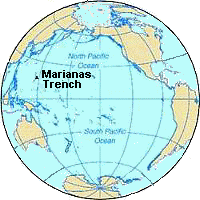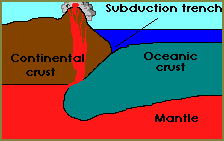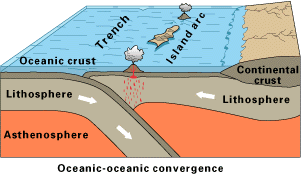 The Marianas Trench: It's the deepest spot in any ocean of the world. It is located in the Pacific Ocean, just east of the Phillippines. Nearby is the island of Guam, a U.S. Territory inhabited by natives identified as Chamorros. The Marianas trench is sometimes called the 'Challenger Deep' because it was located and named after His Majesty's Ship 'Challenger' of the British Royal Navy in the 19th century. The Marianas Trench's depth is about 10,924 m, or almost 11 km (7 miles). This is a height greater than any mountain on the surface of the earth! Plate Tectonics is a description of the surface of the earth. The interior of the earth, called the mantle, is hot, molten lava. The solid crust, which is in pieces, floats on this magma, much like the shell of chocolate on a dipped icecream cone sits on the icecream. As hot magma rises through cracks in the crust, it pushes pieces of crust apart. In other places, crust pieces are forced together, where they buckle to form mountains. The oceanic crust is much heavier than the continental crust, so when these plates crash into each other, the oceanic plate plunges downward toward the molten mantle, while the lighter, continental plate rides up over the top. The forces driving the two plates together are really intense, so the underlying oceanic plate (the 'subducted' plate) creates a trench where it drags the edge of the continental crust down as it descends underneath. (check out the picture).  The really deep part of the ocean is in the bottom of the trench created by this subducting ocean crust. The Marianas Trench, for example, marks where the fast-moving Pacific Plate converges against the slower moving Philippine Plate. Subduction also results in the formation of volcanoes. Over millions of years, the erupted lava and volcanic debris from the escaping magma pile up on the ocean floor, until a submarine volcano rises above sea-level to form an island volcano. The Phillippines, the Marianas Islands are examples of this. Such volcanoes are typically strung out in chains called island arcs. As the name implies, volcanic island arcs, which closely parallel the trenches, are generally curved. Because of their nearness to the the tectonic activity below, they experience numerous strong earthquakes.  Volcanoes can also form where the sea-floor crust passes over a 'hot spot' ... a spot where the crust is very thin and the hot layers below have broken through. As the moving crust passes over this hot spot, volcanoes form. The volcanoes sometmes reach all the way to the surface of the ocean, forming islands. As the crust continues to move, new volcanic islands are formed in sequence. This is how the Hawaiian Islands were formed; the island of Hawaii is currently over the hot spot. [Our thanks to Simon Jowitt of Camborne School of Mines in Cornwall, UK for correcting an error we made here]. Many strange creatures live in the perpetual dark and crushing pressure of this deep ocean floor. More to come. |